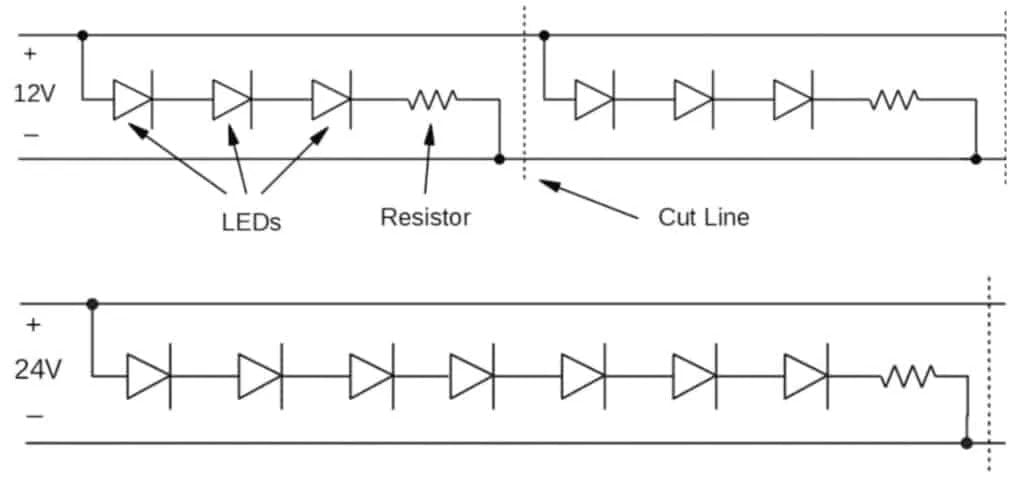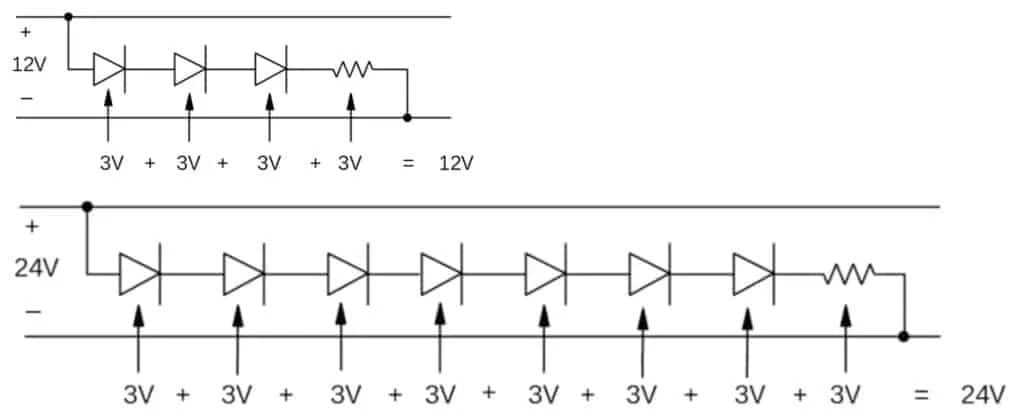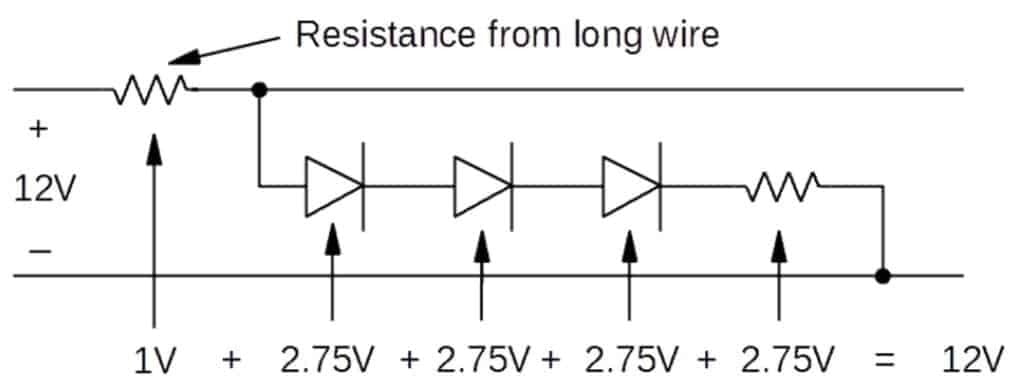LED Strip Voltage Selection: 12V or 24V – How to Decide?
Table of Contents
LED strips commonly operate at 12VDC or 24VDC, with both options equally priced. When deciding which one to purchase, you might wonder about the dissimilarities between the two.
At MylikeLed, we offer both 12VDC and 24VDC LED strips. Generally, the disparity between a 12VDC LED strip and a 24VDC LED strip is insignificant if you select the appropriate power supply. We suggest opting for a 12VDC LED strip if you require a shorter length. Compared to a 24VDC LED strip with the same number of LEDs, the 12VDC version allows for a cut length that is half as long. This grants you more flexibility to tailor the LED strip to your desired length.
On the other hand, if you need a longer linear run and desire higher luminous efficiency, we recommend choosing 24VDC LED strips. For those intrigued by the technical aspects and seeking more detailed information, please continue reading below for further distinctions:

12V LED Strips Have Shorter Cut Lengths
Regardless of whether they are installed on a 12V strip or a 24V strip, most individual LED chips operate on 3VDC power. The same LED chip can be used on both a 12V strip and a 24V strip. The key distinction lies in the design of the strip’s circuitry.
LED strips are arranged in groups of LEDs, and each group’s size depends on the strip’s voltage. A 12V strip typically consists of 3 LEDs, while a 24V strip may have 6, 7, or even 8 LEDs per group. The cut lines are positioned between these groups. Consequently, if the size of each LED group is smaller, the cut lines can be placed closer together.
To illustrate, please refer to the diagrams of the 12V and 24V LED strips shown below:

If your installation involves numerous corners with shorter lengths, opting for a lower voltage 12VDC strip with closer cut lines can be beneficial. This choice helps reduce dark areas at the corners, ensuring better illumination.
For those seeking the advantages of a long run provided by the 24VDC LED strip and the shorter cutting length offered by the 5VDC LED strip, our team has developed the Mini Cutting LED Strip. With this innovative solution, you can achieve a single LED per cut at 24VDC.
The application scenarios for a 12V LED strip are extensive
Since 12 VDC is a widely used voltage, the compatibility of LED strips with this voltage can eliminate the necessity for extra power supplies. For instance, when installing lights in a vehicle, a 12 VDC LED strip light can often be directly connected to the existing electrical system, offering a more convenient installation solution in numerous situations. It is crucial, however, to verify your existing system before making a purchase, as there can be exceptions to this general rule.

24V LED Strip: Facilitating Extended Linear Installations
A higher voltage strip offers the advantage of supporting extended linear runs without experiencing significant voltage drops.
Understanding Voltage Drop
Voltage drop refers to the reduction in voltage that occurs as electricity flows through a wire or conductor. In the context of LED strips, it leads to a decrease in brightness along the length of the strip.
Understanding the Occurrence of Voltage Drops
When electrical current flows through a wire, it encounters resistance. The longer the wire, the more the resistance, resulting in a voltage drop. As a result, LEDs at the end of the strip receive less voltage than those near the power supply, causing a noticeable difference in brightness.
Exploring the Role of Higher Voltage in Countering Voltage Drop
To comprehend the impact of higher voltage, it’s essential to understand the configuration of components in an LED strip.
LED chips are connected in series within groups, with each group comprising several LED chips and a resistor. The total voltage drop across the group must match the overall voltage of the strip (refer to the diagrams below). By utilizing a higher voltage, the strip’s circuitry is optimized to accommodate longer runs, reducing the impact of voltage drop and maintaining consistent brightness levels throughout the strip.

Next, the groups are connected in parallel and positioned sequentially along the strip’s length.
First, observe the diagrams above and note that a 24V strip consists of groups with 7 LEDs, whereas a 12V strip has only 3 LEDs per group. Later on, I will explain the significance of this disparity.
Each wire possesses a specific level of electrical resistance when current flows through it. As the wire’s length increases, so does the resistance, resulting in a more considerable voltage drop. Eventually, this increase becomes substantial enough to affect the brightness of the LEDs. Below is an illustration demonstrating this scenario on a 12V strip.

The diagram provided shows that the voltage across the LEDs has decreased from 3.0V to 2.75V.
Upon transitioning to 24V, two changes occur that lead to a reduction in the voltage drop.
When the voltage is doubled (12V to 24V), the current is halved by Ohm’s law (I=U/R). Consequently, the voltage drop across the lengthy wire is also halved. Therefore, instead of a 1V drop, it becomes a 0.5V drop.
The impact of this 0.5V drop is distributed among the eight remaining circuit components, as opposed to four in the case of 12V.

Note that the voltage across the LEDs has decreased to 2.9375V, as opposed to 2.75V when using the 12V strip.
Suppose you have a situation where extensive strip lengths are necessary; in that case, it might be prudent to opt for 24V strips. Nevertheless, it’s essential to acknowledge that even 24V strips have limitations. Alternative techniques may need to be employed to prevent fading of your LEDs towards the end. One such solution is utilizing our Super Long Constant Current LED Strips.
The efficiency of a 24V LED strip tends to be superior
Increasing the voltage can lead to enhanced efficiency. Whenever there is a voltage across a resistor, it signifies that energy is being transformed into heat instead of light. As such, the resistors in the previous diagrams are essential, yet they also contribute to energy wastage.
| The total voltage of the strip | Voltage across resistor | % Power “wasted” on resistors |
| 5V (1 LED Per Group) | 2V | 40% |
| 12V (3 LEDs Per Group) | 3v | 25% |
| 24V (7 LEDs Per Group) | 3v | 12.5% |
It becomes clear that strips with a higher voltage experience less energy loss. LEDs consume such negligible energy that the impact is minimal for small-scale setups. However, the disparity in power consumption can become notable in larger spaces or commercial applications.
Our team has engineered high-efficiency LED strips with 8 LEDs per segment, achieving up to 190LM/w.
This aligns with the principle used in high-voltage power transmission. As voltage increases, the current decreases. Based on Ohm’s law, which states that the voltage drop Vdrop=I * R, and the electrical energy converted to heat P=U * I = (I * R) * I = I 2 * R, the correlation becomes clear.
A 24V LED strip necessitates a thinner conductor gauge
The formula P = V * I, calculates the electrical power computation. To preserve the same power (P), an increase in voltage (V) demands a corresponding decrease in current (I).
Let’s take 48W as a specific output target for understanding. A 12V system would necessitate 4 Amps (12V x 4A = 48W), whereas a 24V system would only need 2 Amps (24V x 2A = 48W).
Simply put, a 24V LED system will consume half the current of a 12V LED system to achieve an equivalent power level.
Why does this matter?
The thickness and breadth of copper conductors needed to transport power safely are dictated by total current, not voltage.
If an excessive amount of current is pushed through a narrow or small copper conductor, the resistance within the conductor becomes significant, leading to voltage drop and heat generation. In extreme circumstances, this could even result in electrical fires.
Given everything else is equal, a 24V LED system would need half the electrical conductor that a 12V system would. You can use the voltage drop calculator to ensure you are still using sufficient conductor gauges for your LED strip projects.
Smaller power supplies for 24V LED strip
Similar to conductor size, the size of the power supply is mainly determined by current, not voltage. The relationship between electrical current and conductor size needs, given that a large portion of a power supply unit’s internal wiring consists of copper wiring, influences this.
The power supply size can be crucial for projects like LED strip lights in under-cabinet installations, where space might be limited.
Final Thoughts
Hopefully, this article has illuminated for you, as it has for me, the significant benefits of opting for 24VDC LED strips over their 12VDC counterparts. For substantial lighting projects, we strongly recommend using 24VDC LED strips.
At MyLiKeLed, we pride ourselves on manufacturing top-tier LED strips and LED neon flex. Each product we produce passes through state-of-the-art laboratories to ensure supreme quality. Moreover, we provide customization options for our LED strips and neon flex to cater to your specific needs. Don’t hesitate to contact MyLiKeLed for superior LED strip and LED neon flex solutions!
FAQs
The main difference is the operating voltage and how far you can run the strip without voltage drop.
12V LED strips are common for smaller projects and vehicles, while 24V strips handle longer runs better because they maintain consistent brightness over greater distances.
For most home uses, 24V is better if you’re covering large areas; 12V is fine for short runs or small spaces.
24V LED strips are more efficient for longer installations like cove lighting, while 12V is great for under-cabinet lighting or accent spots.
Not necessarily—voltage doesn’t directly determine brightness.
Brightness depends on the LED type and density on the strip; both 12V and 24V can be equally bright if they use the same LEDs.
Both are equally safe for typical use when installed correctly.
They are considered low voltage systems, minimizing electrical hazards, but you must always match them with proper drivers and follow basic wiring safety.
No, you should never connect a 12V strip to a 24V power source.
Doing so can instantly burn out the LEDs because they are not designed to handle the higher voltage.
Choose 24V for longer runs to avoid voltage drop.
24V strips allow you to install longer sections without the lights dimming toward the end, making them ideal for large installations.

Hi, I’m Xylia Xiong, a sales professional with 14 years of experience in the LED strip light industry. I specialize in providing tailored solutions, leveraging my expertise in LED products and the latest industry trends. Known for effective communication and problem-solving, I’m dedicated to helping lighting manufacturers, importers, and distributors achieve their goals.
Let’s work together to create customized solutions that exceed expectations.
Related Posts

The Best LED Strip Lights You Can Buy Right Now

Comparing WS2811 Vs WS2812B: Key Differences


